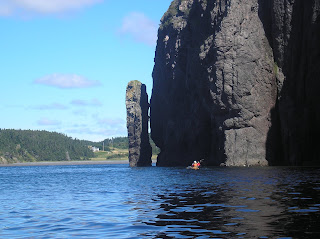Prevention and rehabilitation of the spine by physiotherapists has for years focused on strengthening of the abdominals and back muscles. In addition, it made sense to strengthen hip, lower leg and shoulder muscles so that secondary stress wasn't transferred to pressure sensitive more inert structures in the spine.
The biggest myth, with all the new marketing and promotion, is that core training or core strengthening is just about the abdominals.
Not true. Many injuries can be caused by hip tightness and resultant muscle imbalance in the hip and pelvis region. And since functionally we don't just isolate one group of muscles in an activity, it is not a good training strategy to minimize the lower extremity workout.
For kayakers a reasonable training circuit in addition to paddling might include:
1. aerobic training - 30-40 minutes/day of walking/jogging , biking, swimming or elliptical trainer
2. stretching - forward, backward lateral lunges, hamstring stretches(the yoga sun salutation is a good series of stretches that may be a good basic foundation)
3. strengthening - transversus abdominal tightening(key to many standing and stabilizing movements), plank position from yoga, side bridge, pushup, bridge, on floor mini crunch, mini squats, physio ball exercises - crunch pushup, seated on ball arm curls, shoulder/hip exercises using theraband.
For core stability a key concept in almost every movement is that you contract isolate the lower abdominals making sure you can activate the transverse abdominal muscle that crosses like a wide belt from one side of the pelvis to the other.
Cueing this muscle to work is best achieved by lying on your back:

If lying on the floor/mat: think of bringing the belly button straight down by tightening the lower abdominals(the horizontal band going from one side of the pelvis to the other). Hold and breathe. After several attempts move on to using light weights and curling the arms while tightening. Another option is lift one knee up towards your chest all the time activating this muscle group or slowly lower(straighten) one leg to the floor.

Provided you contract the tranversus(TrA) abd muscle at the same time use a ball as a bit of a challenge. Keep the hips and knee slightly flexed to minimize risk to the lumbar spine. We introduce this concept in judo classes by having the kids pass the ball using their feet to hold onto the ball. A simple and functional way of activating the stabilizers in preparation for snowboarding, martial arts and kayaking.

You can use the ball if this is comfortable or lie on the floor with the knees bent. Keep the head and neck in neutral.

Progressions include: rolling side to side, roll to the side, stabilize while lifting 1 arm, alternate lifting of 2 arms, lift/extend one leg.

In kayaking the obliques factor into the stroke as well as the hip extensors, hip abductors and adductors - so doing training on the ball, is a very useful and effective means of promoting the strength in these muscles.
There are numerous strategies - these days a dizzying array of options. You can keep it simple though. For conditioning, walk, run or swim. Work yourself up to the amount of time that is comfortable for you. There is a range of arm and leg exercises you can use including yoga moves and or taichi martial arts movements or you can hit the weights. Weight training with free weights and theraband is a bit different from the stationary machines we see in the gyms today. They are convenient but a few are not designed for the average user. More on specific exercises later.



















































